Physical Address
304 North Cardinal St.
Dorchester Center, MA 02124
Superior labrum anterior to posterior (SLAP) lesions have been recognized as a cause of shoulder pain since the mid-1980s. Controversy regarding normal variant labral anatomy versus truly pathologic lesions causing consistent clinical symptoms surfaced almost immediately thereafter. Snyder and colleagues described the pathologic anatomy of four types of SLAP lesions and the implications for treatment ( Figs. 44.1 and 44.2 ). Other authors have described additional tear patterns. Although the true incidence of SLAP lesions is unknown, in the initial study by Snyder and colleagues, the percentage of SLAP repairs as a function of their overall surgical cases was quite low (3.3%). This percentage increased slightly to 4.7% in a follow-up study in 1995. Rates have varied slightly from these low numbers in other series.
While the published literature consistently suggests that SLAP lesions are relatively uncommon, disproportionate enthusiasm for operative intervention for this diagnosis has been noted. A review of two statewide databases found that SLAP repair volume increased 238% from 2002 to 2009 and 20% from 2005 to 2009, compared to an overall orthopedic case volume increase of 125% and decrease of 14%, respectively. This may be related to the high incidence of false-positive radiologic interpretations of magnetic resonance imaging (MRI) scans. An investigation performed by Weber and Kauffman showed that up to 35% of community-read MRI scans were interpreted as either a labral tear or a “possible labral tear.” Superior labral tears diagnosed on MRI in middle-aged and older patients are likely to actually be normal age-related changes as evidenced by Schwartzberg et al., which showed rates of labral tear in asymptomatic 45- to 60-year-old individuals of 55% and 72% as read by two fellowship-trained musculoskeletal radiologists.
Clinical findings upon examining the shoulders of patients with SLAP lesions are also inconsistent. Although a number of tests and clinical examination maneuvers have been suggested, all have proved to be difficult to validate ( Table 44.1 ). These issues create problems for the surgeon in the diagnosis of SLAP lesions preoperatively. The interpretation of intraoperative findings is also difficult, and even experienced surgeons disagree regarding which findings represent a normal variant, such as a sublabral recess ( Fig. 44.3 ) that requires no treatment, and which findings are pathologic. Electing for operative intervention involves carefully assessing the history, physical examination, and imaging findings, and then critically condensing the results into a patient-specific treatment plan.
| Clinical Test | Works Inconsistently | Failure to Validate |
|---|---|---|
| Snyder biceps compression test | Weber and Higgins ; Kim and McFarland | |
| Jobe relocation test | Weber and Higgins, 70% sensitivity Guanche and Jones, 73% sensitivity |
Mileski and Snyder |
| Kibler anterior slide test | Kim et al. | |
| Liu crank test | Guanche and Jones Stetson |
|
| O'Brien active compression test | Guanche and Jones Morgan and Burkhart |
Ottl et al. Kim and McFarland |
| Speed test | Holtby and Razmjou |
SLAP lesions can be degenerative or traumatic. Maffett et al. suggested that traction on the overhead or abducted arm is a common traumatic mechanism. Snyder et al. described the injury as being due to compression from a fall on the outstretched arm. Throwers are at high risk from attritional superior labrum lesions. Burkhart and Morgan described the “peel-back” mechanism where abduction and external rotation shoulder position places a torsional force on the posterior superior labrum and biceps anchor, causing the detachment of the anchor and a SLAP tear. Overuse symptoms created by activities performed below the shoulder generally do not cause labral pathology, and positive MRI scans obtained in this subset of patients should be viewed with suspicion. Because natural degeneration of the labrum occurs with age, other shoulder pathology is more relevant in older patients, and the SLAP lesion can be incidental. Most persons with symptomatic SLAP lesions present with posterior pain, typically with overhead activities. Night pain and pain at rest are atypical. Mechanical popping, catching, or grinding can suggest on unstable flap. Isolated SLAP lesions are uncommon, and thus many of the symptoms may be masked by other diagnoses such as impingement, bicipital tendonitis, and acromioclavicular pain. Patients presenting with shoulder instability often have extension of the labral damage into the superior labrum, and a high index of suspicion is necessary in this subset of patients. However, for the most part, the history will be nonspecific, and recognizing the appropriate demographic in which SLAP lesions occur remains the most important part of the history.
Identifying symptomatic SLAP lesions on physical examination remains challenging because significant clinical findings upon examination of the shoulders of patients with SLAP lesions are inconsistent. The physical exam can be suggestive of a SLAP tear, but it is rarely conclusive. The O'Brien active compression test is one of the more common provocative maneuvers. For this test, the shoulder is positioned in 90 degrees of flexion, internal rotation, and slight horizontal adduction. The test is positive when resisted shoulder flexion causes deep shoulder pain that is relieved with repeat exam of resisted shoulder flexion in external rotation. Although a number of other tests and clinical examination maneuvers have been suggested, they have all proved to be difficult to validate. The only test Weber and Kauffman found to have reasonable sensitivity was the apprehension test, but this was still poor. The inability of other surgeons to reproduce the sensitivities and specificities described by the physician who originally performed the test led Kim and McFarland to state, “… our findings question the diagnostic value of the clinical assessment of SLAP lesions.” Snyder and colleagues continue to make the argument that “there is no physical finding specific for SLAP lesion of the shoulder.” Walsworth et al. noted that even combining tests did not improve the results of physical examination testing. Consistent with the history, the presence of other pathology can render the identification of SLAP pathology difficult. SLAP lesions are difficult to diagnose clinically, and tests must be performed in the context of the clinical history and the appropriate patient demographic.
Radiographic evaluation, including true anterior-posterior (AP) shoulder (Grashey view), axillary lateral, and scapular Y views, is used to identify other potential sources of shoulder pain. MRI is the mainstay of preoperative imaging. Noncontrast MRI remains the most common tool used to diagnose labral pathology. However, radiologic review of these studies remains highly variable. Kauffman and Weber showed that up to 35% of community-read MRI scans were interpreted as either a labral tear or a “possible labral tear,” which is a worrisome statistic when the true incidence is probably between 3% and 5%. Clearly the orthopedist will need to become confident in interpreting MRI images of the labrum if the study is to be useful. Higgins and Weber found that only 5 of 64 patients with surgically confirmed SLAP lesions were correctly diagnosed by the preoperative radiologist reading ; however, the use of contrast material may improve these results ( Fig. 44.4 ). Overall, Belanger and Green noted that “MRI was non-specific in identifying SLAP lesions,” and Mileski and Snyder stated that “diagnostic arthroscopy remains the only definitive way to diagnose SLAP lesions of the shoulder.” A less common but important finding on MRI is a paralabral cyst, which is usually pathognomic of a labral tear. A paralabral cyst extending to the spinoglenoid notch from a posterosuperior labral tear can compress the suprascapular nerve and cause painful infraspinatus dysfunction ( Fig. 44.5 ). In a large series of spinoglenoid notch cysts causing suprascapular nerve entrapment by Moore et al., 20 out of 22 spinoglenoid notch cysts were identified on preoperative MRI. Of those patients who underwent arthroscopy, 10 out of 11 cysts were associated with superior labral tears. Clearly, orthopedists who treat the shoulder will need to become facile in interpreting MRI scans of the shoulder, especially because numerous normal anatomic variants, such as sublabral recesses, can confound the interpretation of the scan. Despite advances in the performance and interpretation of MRI of the shoulder, surgeons need to be prepared to diagnose and treat SLAP lesions as they present at surgery. Arthroscopy is still the gold standard in the diagnosis of labral tears, and the surgeon should be prepared to address these lesions.
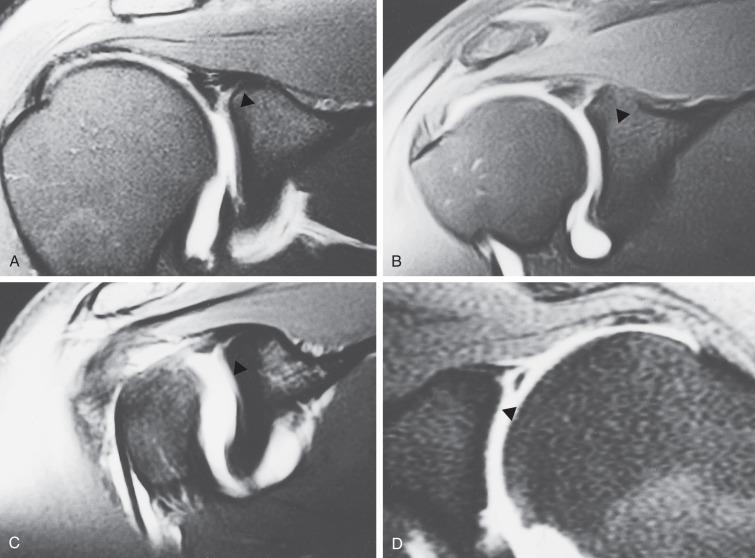
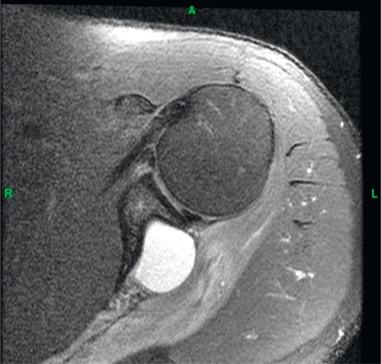
Decision-making with regard to the treatment of patients who may have SLAP pathology remains difficult. As previously indicated, the diagnosis will rarely be made by a clear-cut history, physical examination, or imaging study. The clinical information that is available with regard to this complicated problem is straightforward on one subject: SLAP lesions are relatively rare. True incidence rates are not available, but a number of studies have suggested that the percentage of SLAP lesions as a function of the total number of cases remains fairly low. Snyder et al. had a percentage rate of 3% of their total shoulder cases, which increased to 5.9% in a subsequent follow-up study. Subsequent studies have shown varying rates from 2% to 12%. A review of American Board of Orthopaedic Surgery (ABOS) II data from 2003 to 2008 has shown a significant increase in the actual number and percentage of SLAP repairs among candidates, at 10% of shoulder cases. However, another review of the ABOS database from 2003 to 2010 show no statistically significant increase in the likelihood of performing SLAP repair among those candidates performing at least 1 SLAP repair. Candid assessment of the percentage of SLAP lesions performed by each surgeon may allow one to assess the indications selected for repair.
Another important factor is age. Numerous authors have suggested that patients older than 40 years may be better served by arthroscopic biceps tenodesis than SLAP repair. The reasons are probably multifactorial, but again, labral degeneration is more common with age, and age-related biceps changes may make SLAP repair impractical. Erickson et al. conducted a systematic review of SLAP repairs in patients 40 years of age and older and found significantly higher failure rates compared to those under 40 years old. They noted decreased patient satisfaction, increased re-operation rates, and increased postoperative stiffness with increasing age.
Older patients often have substantial additional pathology, the correction of which may further increase the morbidity of the procedure. Multiple studies have investigated concomitant rotator cuff tears. Franceschi et al. conducted a randomized trial of SLAP repair versus bicep tenotomy for patients over age 50 with type II SLAP tear undergoing concomitant rotator cuff repair and showed no benefit with regard to clinical outcome score or range of motion (ROM) with SLAP repair. Abbot and Busconi showed improved outcomes scores and pain relief with simple débridement of the type II SLAP tear with concomitant rotator cuff repair when compared to SLAP repair in patients over age 45. Oh et al. compared débridement, biceps tenotomy, and biceps tenodesis with concomitant rotator cuff repair and all groups showed improved pain, ROM, and outcome scores. The biceps tenotomy group showed decreased bicipital groove tenderness but lower forearm supination strength compared to tenodesis and debridement. Simple débridement showed the least “Popeye” deformity. Most of the evidence to date supports one of these alternatives, débridement, biceps tenotomy, or biceps tenodesis, rather than SLAP repair with concomitant rotator cuff repair. Initial nonoperative treatment of a suspected SLAP lesion remains the primary choice for virtually all patients. Blaine et al. showed a high rate of success with this approach. Whether the MRI diagnosis was a false-positive or the SLAP lesion healed is difficult to determine; nonetheless, the success rate was high. Jang et al. found demand for overhead activities, a history of trauma, or mechanical symptoms predicted failure of their nonoperative treatment. Careful observation and differential injection can further define additional treatment that may be needed, given that SLAP lesions rarely occur in isolation. Clearly a radiologic report of a “possible SLAP lesion” is not in itself an indication for surgery. Assuming that the history, physical examination, imaging study findings, and demographic category of the patient fit the diagnosis of a SLAP lesion and nonoperative treatment fails, then diagnostic arthroscopy can be undertaken to identify if in fact a symptomatic SLAP lesion is the cause of the symptoms.
Even when diagnostic arthroscopy is performed, the decision-making can be difficult. Numerous studies have shown that even experienced surgeons vary widely in their determination of which lesions are pathologic. Whereas special assessments, such as the sulcus score of Mihata et al., may prove useful, even a visual diagnosis of SLAP lesions at surgery remains controversial. Although the diagnosis of type III and IV lesions is relatively straightforward, the diagnosis of type I and II SLAP lesions remains elusive. Data from both Snyder et al. and Weber and Higgins suggests that the presence of granulation tissue at the base of the labral attachment indicates a high specificity for a SLAP lesion ( Fig. 44.6 ). Given the high complication rates reported with SLAP repair, the decision to perform such a repair should not be made lightly. As previously suggested, older patients and those with concomitant rotator cuff tears may be better served by a biceps tenodesis or tenotomy.
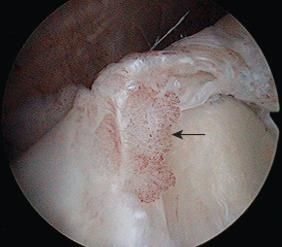
A good indication for SLAP repair is spinoglenoid notch cyst with symptoms of suprascapular nerve compression. Shon et al. showed good to excellent results in 90% of patients with intra-articular decompression of the cyst and superior labral repair. All patients who had postoperative MRI at 6 months had complete resolution of the cyst and neurogenic infraspinatus muscle edema. Kim et al. showed similarly good results with their technique of subacromial decompression of the spinoglenoid notch cyst and SLAP repair. However, it is not clear if cyst decompression is required in this setting. In a prospective cohort study by Kim et al., 28 patients were treated with either SLAP repair and cyst decompression or SLAP repair alone. There was no significant difference between groups with regard to outcomes or cyst resolution, and 25 of 28 showed total resolution of the spinoglenoid cyst. This provides further evidence that SLAP repair is effective management of a SLAP tear with a spinoglenoid notch cyst.
A variety of treatment options exist for symptomatic SLAP lesions. Simple débridement, as originally reported, has been shown to have a high rate of failure in the athletic population, but it is usually appropriate for some type I ( Fig. 44.7 ) and type III SLAP lesions. Biceps tenotomy has also had its advocates and remains a simple, quick procedure for patients with lower demands on the shoulder, although cramping and deformity can occur, and appropriate preoperative informed consent is required. For the most part, treatment options center around repair or tenodesis. As previously discussed, tenodesis may be the appropriate choice for older patients, in a revision situation, or for a type IV SLAP lesion ( Fig. 44.8 ). Both proximal arthroscopic and distal mini-open subpectoral techniques have been proposed. Kauffman et al. and Sekiya et al. have had success with proximal tenodesis techniques, which have shown good results with low revision rates, even at long-term follow-up.
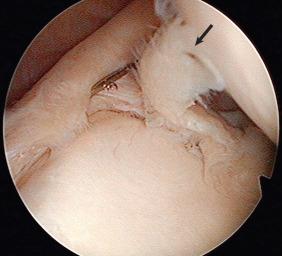
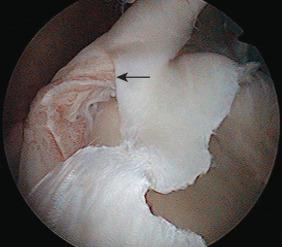
SLAP repair is a reasonable treatment for younger, active patients with a symptomatic SLAP lesion. Although the use of tacks was initially proposed, these techniques have been largely abandoned because of high complication rates. Currently the standard of care is suture anchor repair. Biomechanical studies have shown varying results of load to failure when comparing the simple versus the mattress suture technique, as well as a number of anchors and configuration. Suture anchor placement anterior to the biceps has been shown in a biomechanical study to decrease shoulder external rotation, which may be detrimental to the overhead athlete. No prospective, high-level studies have been performed to analyze the type of repair and number of anchors to be used. Recent anecdotal reports of knot “squeaking” have led some surgeons to revert to the use of bioabsorbable sutures for repair, especially as a result of articular cartilage injury. Knotless anchors may have some technical advantages, but Sileo et al. showed decreased load to gap formation at the repair site in a cadaver model compared to knotted anchors. The choice of anchors, configuration, simple versus mattress sutures, and knotted versus knotless anchors are all up to the preference of the surgeon, given the lack of prospective, comparative data.
The technique used by the authors is based on preference rather than on data from solid studies. Nonoperative treatment of all suspected SLAP lesions is preferred initial management for the reasons previously discussed, with the exception of spinoglenoid notch cysts compressing the suprascapular nerve and mechanical symptoms associated with an unstable flap (type III). When nonoperative treatment fails and a symptomatic SLAP lesion is suspected, diagnostic arthroscopy is indicated. If the clinical, imaging, and surgical findings support the presence of an isolated, symptomatic, unstable type II SLAP lesion without a paralabral cyst, we prefer to manage this with subpectoral biceps tenodesis in younger, high-demand patients, and biceps tenotomy in older low-demand patients. We perform SLAP repair and decompression of the cyst for patients with spinoglenoid notch cyst, and we perform SLAP repair in the setting of combined anterior and/or posterior labral repair. We prefer to use biocomposite labral anchors (2.9 mm) loaded with #2 polyethylene suture for both SLAP repair and biceps tenodesis.
The step-by-step procedure that we use for SLAP repair is as follows:
Standard posterior viewing portal and anterosuperior working portal are created.
The superior glenoid is prepared down to bone using a shaver from an anterior portal ( Fig. 44.9 ).
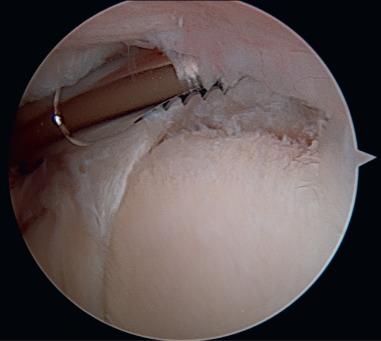
The portal of Wilmington is localized with a spinal needle 1 cm anterior and lateral to the posterolateral corner of the acromion. The drill guide for the anchor is passed percutaneously through the muscular portion of the infraspinatus into the joint.
One or two suture anchors are placed posterior to the biceps anchor through the portal of Wilmington depending on the posterior extent of the tear. A suture passer is used to shuttle one strand of suture around the superior labrum for a simple suture for each anchor.
The sutures are then tied using standard knot-tying techniques ( Fig. 44.10 ).
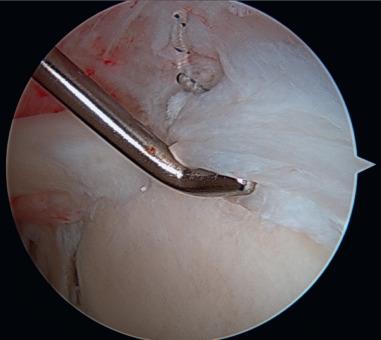
For subpectoral biceps tenodesis, we use the same technique described by Dr. Warner. The bicep tendon is secured to the bone deep to the pectoralis major tendon with a single 2.9 mm double-loaded suture anchor.
SLAP repair or biceps tenodesis are both managed similarly postoperatively. Cryotherapy is used postoperatively, and sling protection is utilized for 4 weeks. Pendulum exercises and passive external rotation start the day following surgery. Active-assisted and passive exercises are started at 2 weeks postoperatively. Active exercises are progressed at 4 weeks after surgery with goal of maximizing the ROM. Progressive strengthening begins at 6 weeks with the goal of clearance to return to sport by 4 months for biceps tenodesis and 6 months for SLAP repair postoperatively. Appropriate preoperative counseling regarding rehabilitation is necessary to provide reasonable expectations postoperatively.
The results of SLAP repairs have generally been reported to be good, based on short-term level IV studies. A prospective analysis by Provencher et al. of 179 isolated type II SLAP repairs showed significant improvements in clinical outcome scores, but also a 37% failure rate and a 28% revision rate. They defined failure as a mean ASES score less than 70, the inability to return to sports or work duties, or undergoing a revision surgery. Age greater than 36 years was the only factor significantly associated with failure (relative risk of 3.45). A review by Weber et al. of the outcomes of ABOS part II candidates with this procedure also showed more modest outcomes, with half of the patients older than 40 years, which is a worrisome statistic given the previous discussion of indications for SLAP lesions. Pain was absent in only 26.3% of patients at follow-up, and function was normal in only 13.1%. Only 40.1% of applicants self-reported their patients as having an excellent result in short-term follow-up. The self-reported complication rate was 4.4%.
Burkhart and Morgan reported an 87% rate of return to sports after SLAP repair in their study. Other follow-up studies specifically directed at return to play (RTP) have found lower rates. In a systematic review, Sayde et al. reported “good-to-excellent” patient satisfaction rate of 83%. However, overall athlete return to previous level of play was 73%, and only 63% among overhead athletes. Fedoriw et al. found a RTP rate of 48% among a series of 27 professional baseball pitchers and 85% for a series of 13 position players. Analyzing more closely the return to previous level of performance based on statistics, they found a return to previous performance rate of only 7% among pitchers and 54% among position players. Although SLAP repairs tend have good results in patients who place a lower demand on their shoulder as measured by standard shoulder outcome scores, return to sport remains problematic in most studies in which this parameter is carefully evaluated.
Superior labral repair versus biceps tenodesis for isolated type II SLAP tears has been a subject of debate, and there is increasing evidence supporting tenodesis as an alternative to repair for many patients. In a retrospective cohort study, Ek et al. showed no difference in ASES scores, patient satisfaction, and return to sports between SLAP repair versus biceps tenodesis. Analysis of their indications showed younger, more active patients with healthy-appearing labral tissue were more commonly repaired, whereas older patients with degenerative or frayed labral tissue underwent biceps tenodesis. Patients were allowed to return to sports faster in the tenodesis group, and there was a trend towards higher RTP rate. Similarly, Boileau et al. found a higher return to sport after tenodesis compared to SLAP repair for type II SLAP lesions. Most recently, Schroder et al. conducted a blinded, randomized, sham-controlled trial of 118 patients with isolated type II SLAP tears indicated for surgical intervention. They found no significant difference in Rowe scores, Western Ontario Shoulder Instability Index, patient satisfaction, or pain scores between labral repair, biceps tenodesis, and sham surgery. They concluded that their data did not support labral repair or biceps tenodesis in this patient population. However, they did not include enough patients to perform a subgroup analysis by age, and the mean age was 40 years.
Complications associated with SLAP repair include persistent discomfort, loose hardware or loss of fixation, persistent rotator cuff defects at the site of transtendon portals, articular cartilage injuries, stiffness, persistent synovitis, and suprascapular nerve injury. Two studies specifically looked at complications of SLAP repair. Weber showed that 2 of 24 patients treated for failed SLAP repair had severe arthritis, and 14 of 24 had articular cartilage injury. Out of 24 patients, 10 presented with postoperative stiffness, and 6 presented with loose hardware, 4 of which were tacks. Mean University of California, Los Angeles (UCLA) scores were only 29.2, representing a fair result, and show that surgical treatment of the failed SLAP repair did not generally have a good outcome. The other study evaluating complications of SLAP repair was performed by Katz et al. Similar to Weber's study, postoperative stiffness was common, involving 78% of their patients. Nineteen percent had loose or prominent hardware, and only 68% were satisfied with their revision surgery. In a review of a single surgeon's shoulder arthroscopy series over a 5-year period, Byram et al. found humeral head abrasion under the articulating portion of the biceps tendon in 13 out of 18 failed SLAP repairs. They postulated this was due to increased biceps-humeral head contact pressure from over-tensioning of the biceps-labrum complex. Self-reported complications in ABOS part II applicants were 4.4%, even in short-term follow-up, and included both medical and surgical complications, such as implant failure, infection, nerve injury, dislocation, wound dehiscence, tendon injury, and implant failure.
Complications after biceps tenodesis include stiffness, infection, nerve injury, and humerus fracture. Nho et al. reported a complication rate of 2% after 353 subpectoral tenodesis procedures, including 2 with persistent pain, 2 with loss of fixation, 1 deep infection, and 1 musculocutaneous neuropathy. Rhee et al. reported four cases of brachial plexus injuries after subpectoral tenodesis. Sears et al. reported two cases of humeral fracture after tenodesis.
Become a Clinical Tree membership for Full access and enjoy Unlimited articles
If you are a member. Log in here